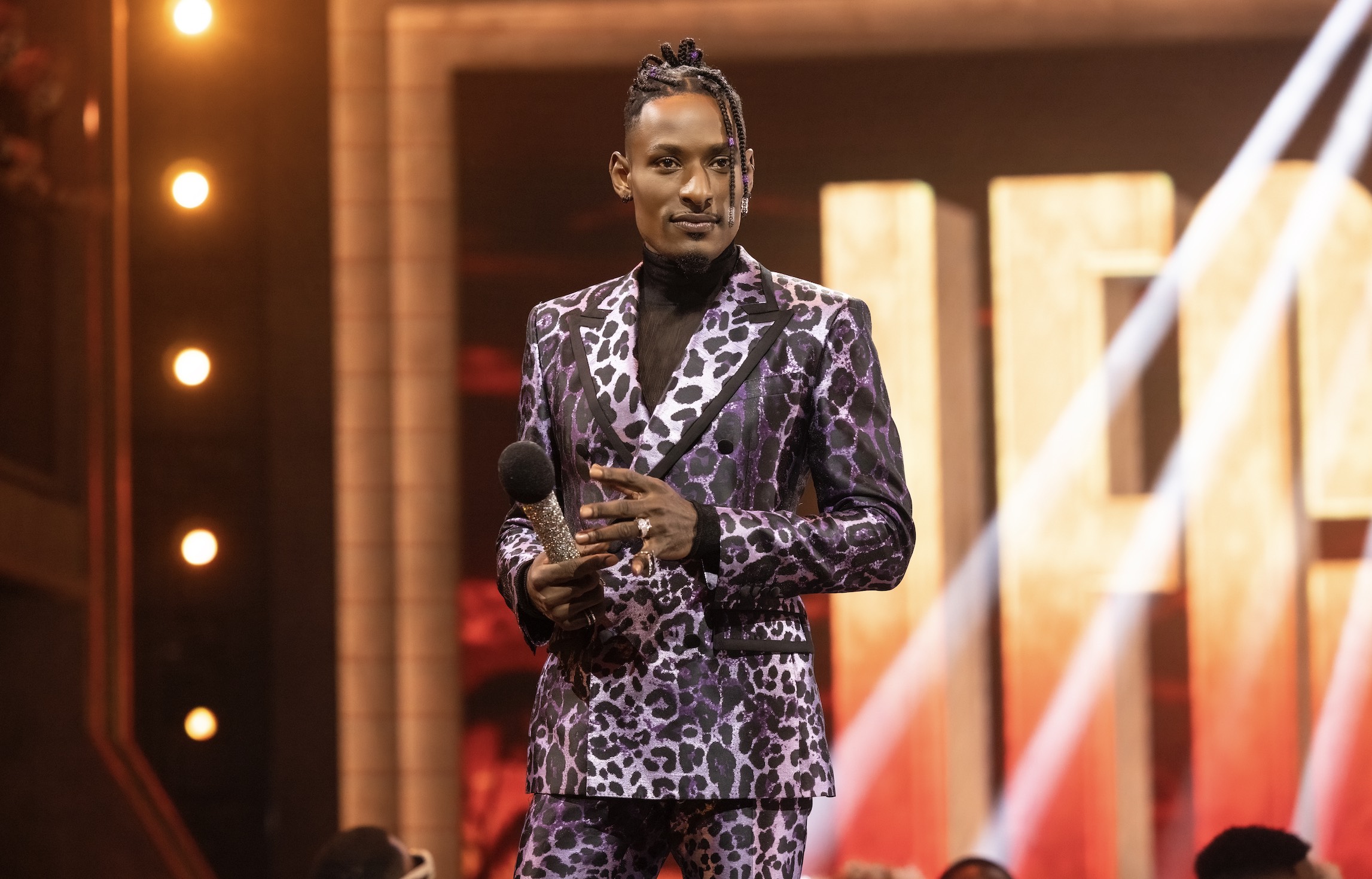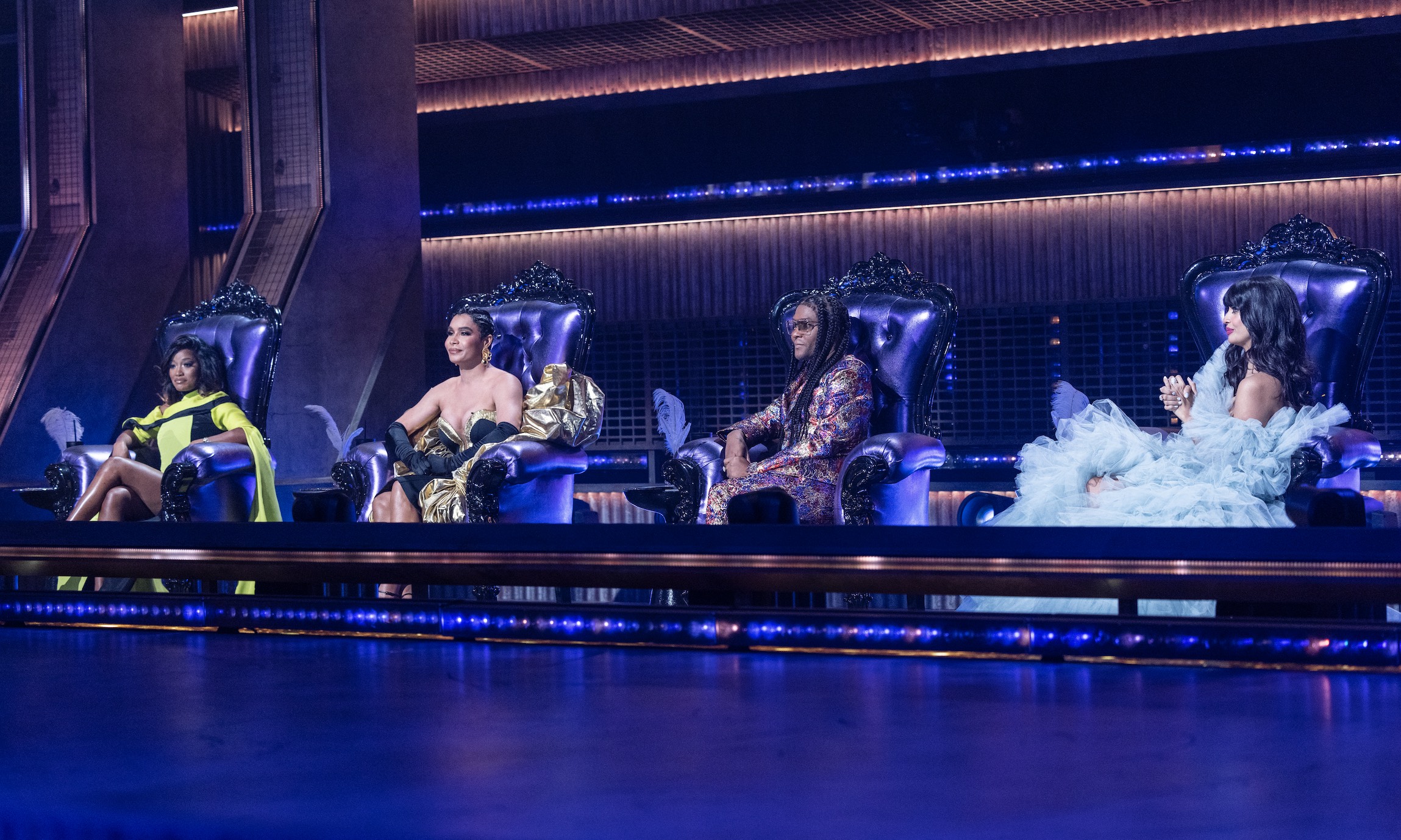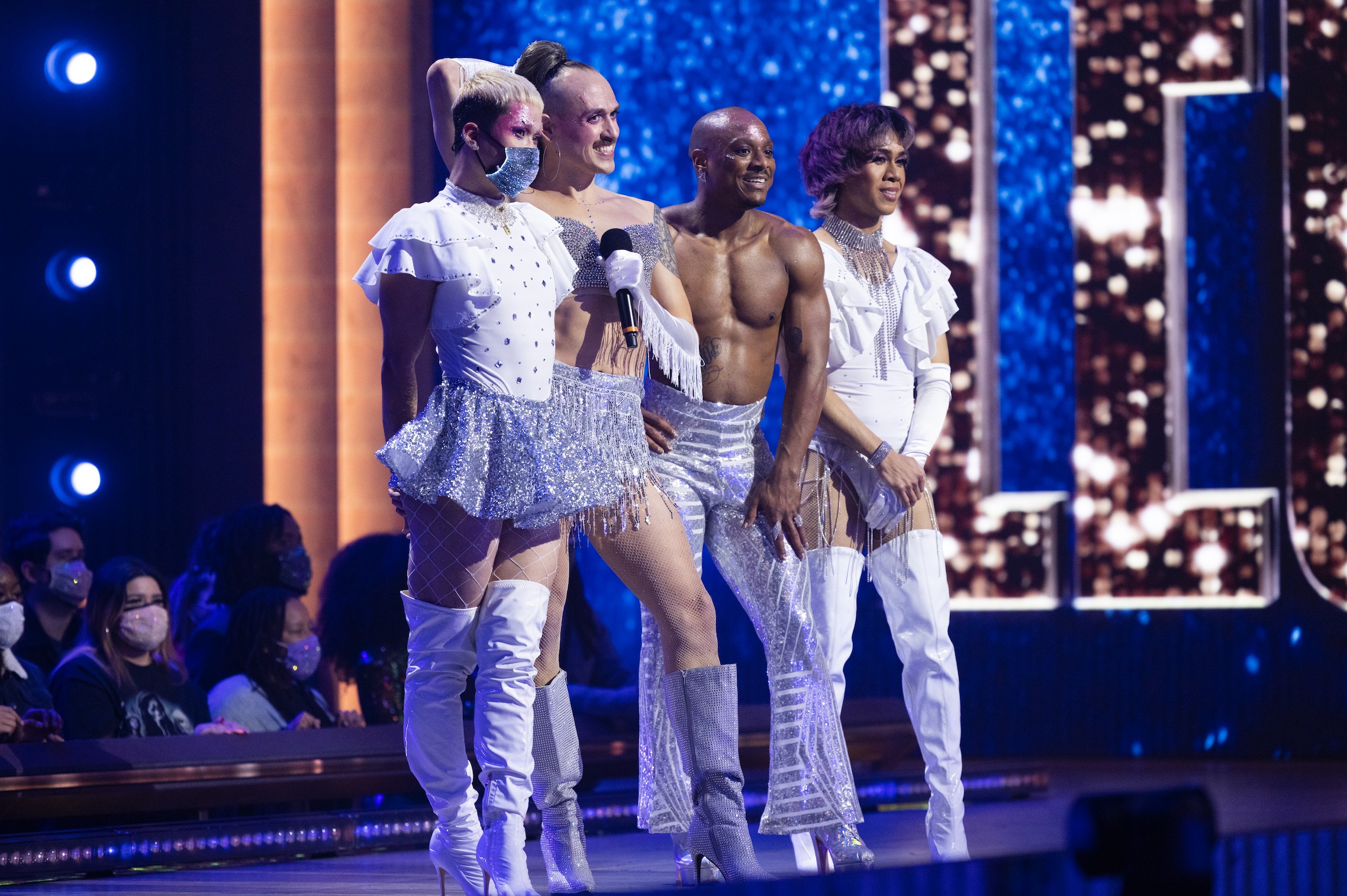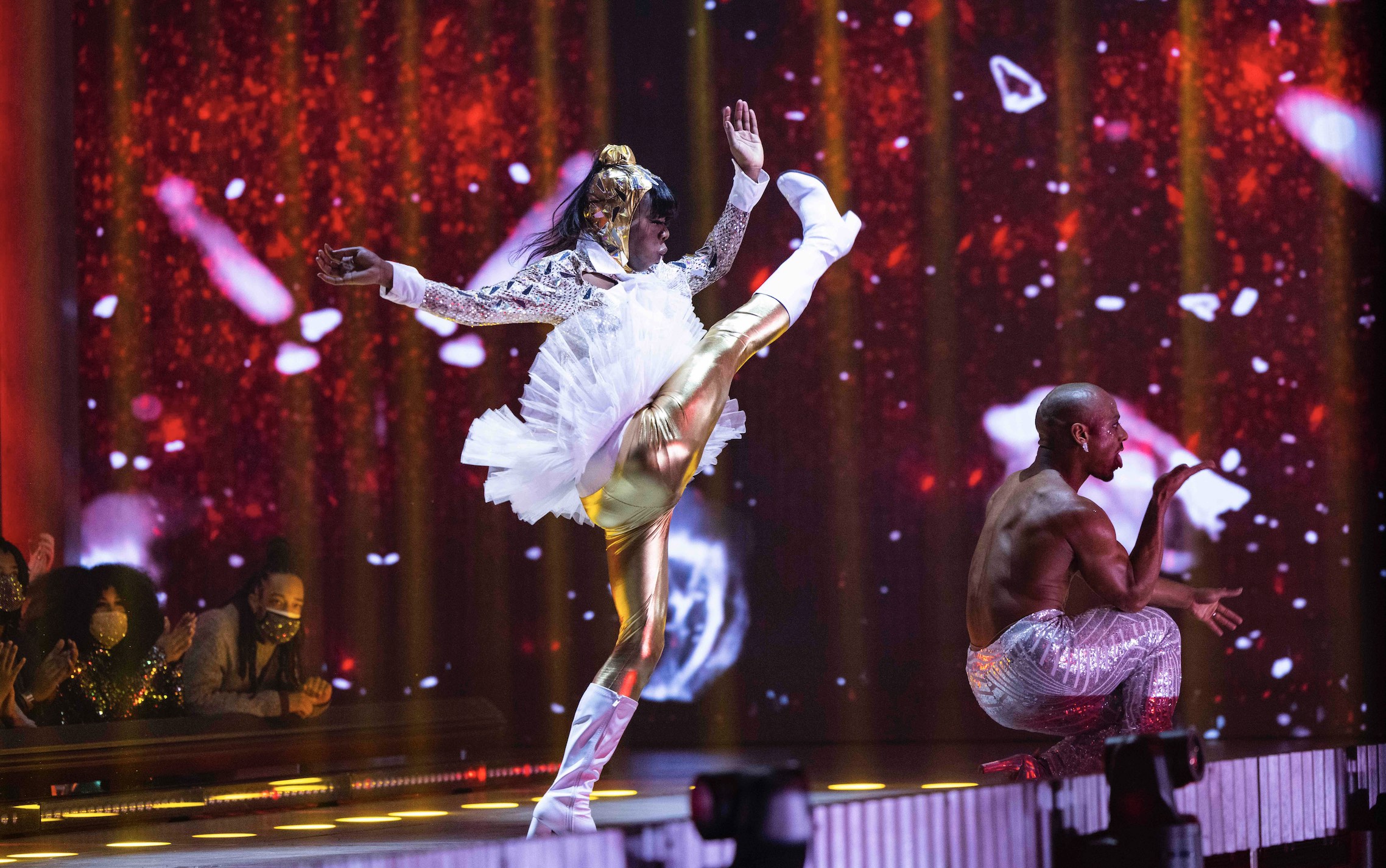Stepping onto the set of Legendary, HBO Max’s groundbreaking ballroom competition series, is like entering a cathedral. The room is expansive, ornate and packed with a lively congregation; at its centre is a runway, down which a procession of dynamic LGBTQ2S+ artists will pop, pose, spin, dip and vogue. There’s a $100,000 cash prize on the line, but the mood is warm and downright celebratory.
“Come as you are,” regales judge and celebrity stylist Law Roach, prompting an enthusiastic roar from the in-studio audience. The massive screen walls project images of stained-glass windows, complementing the holy theme of the most recent performance. Roach’s words—a reminder that all are welcome here—echo throughout the sound stage. If it weren’t for the thumping bass of house DJ MikeQ, you might think you were actually at church.
In bringing the ball to the online streaming world, Legendary highlights why this community has been a vital sanctuary to Black and Latinx LGBTQ2S+ people for decades. It’s shelter, it’s community, it’s inspiration—in many ways, ballroom is church.
On set, filming moves at an impressive clip, rarely relying on reshoots and retakes. As MC, Dashaun Wesley is a calm and commanding presence, ushering the houses, the live audience and future at-home viewers through the ball with ease. With each floor performance, a palpable electricity pulses through the room, but it’s during feedback from the judges where the true power of this platform, of Legendary, shines through.

Credit: John P. Johnson/HBO Max
After an impressive group dance routine, one house mother tears up. She shares that, as a Black trans woman, she had reservations about being on television—that she’d be making herself vulnerable to the whims of production, who might want to “force” a story on her. But as the praise from the judges washes over her, she realizes she and her house didn’t need to fit some narrative to find success on Legendary—they just needed to be themselves. “I am enough,” she says.
“Ballroom was created by Black and brown people 40, 50 years ago,” says Leiomy Maldonado, the “Wonder Woman of Vogue,” in a conversation with her fellow judges backstage. “Because we’ve always been ostracized. We always had to figure out how to do it ourselves—we had to figure out how to celebrate and showcase ourselves.”
Since its inception, Legendary maintains its focus on this foundational tenet of ball culture, creating an unprecedented platform for queer people of colour to put their talent on full display. “It shows people that, no matter what box you put yourself in, or what people put on you, you’re able to celebrate yourself and be who you want to be … and how you want to be respected,” Maldonado says.
Now in its third season, Legendary has done little to mess with its formula. Each week, competing ballroom houses—the chosen-family social structures of the community—go toe to toe in a themed ball, composed of categories that test their skills in dancing, walking, voguing and more. Using a straightforward scoring system, a panel of judges determines the “Superior House of the Week,” as well as the two lowest-scoring houses, which face off in a final vogue redemption battle, and decides who stays and who is eliminated from the competition. After whittling the houses down, week after week, one remains and is deemed the winner, the “Ultimate Superior House” of the season.
“There’s nothing like being in a room … That instant feedback, that instant love—or, for me, most the time, the instant hate—gives us more energy.”
In the first two seasons, the House of Balmain and the House of Miyake-Mugler, respectively, claimed the top honour. This year, 10 new houses enter the fray, including the historic House of LaBeija, as well as the House of Juicy Couture—the series’ first from the “kiki scene,” a newer faction of mainstream ball culture that’s traditionally less competitive and more geared toward socializing and outreach among LGBTQ2S+ youth. Juicy Couture’s inclusion underscores Legendary’s mission to exhibit the full diversity of artistry found within the community.
“When I was first on TV, there wasn’t representation of trans women,” says Maldonado, referencing the time she competed on MTV’s America’s Best Dance Crew in 2009 alongside Wesley. “So, to see that now, and to see how everyone’s different, that’s so beautiful. [On Legendary,] everyone’s celebrated for their differences and for what they bring to the show.”
Having come up in the scene, Maldonado and Wesley take their roles on the show very seriously, ensuring Legendary stays true to ballroom while welcoming in a wider audience. As the show gets bigger and bigger, Wesley says he feels a responsibility to educate everyone “so they know what they’re watching, how to watch it and when to watch it.”
But the goal isn’t to encourage just anyone to jump into ballroom. “You can’t learn that overnight,” says Maldonado. Instead, the judges want to focus on bringing the right people to the forefront, those who, in Wesley’s words, “have been working for years, [putting in] blood, sweat and tears that you’ve never known.”
Legendary has received criticism over who it has brought into its sphere, namely its judging panel who, outside of Maldonado, has little ballroom experience. In addition to stylist Law Roach, the panel also includes actress/activist Jameela Jamil and new addition Keke Palmer, replacing Megan Thee Stallion (though no reason has been given for her departure). And while Jamil and Palmer acknowledge the controversy around their casting, they also point to the fact that, in bringing their individual fan bases to the show, they’re able to enlighten new, curious audiences—all while learning and growing themselves.

Credit: John P. Johnson/HBO Max
“It’s been incredible to be able to learn from Leiomy, and to be able to learn from these contestants,” says Jamil. As she sees it, her function on Legendary is “to be the portal through which everyone who doesn’t know about ballroom can learn through.” Over her three seasons with the show, Jamil has sharpened her knowledge of the scene, showing what it takes to be both a fan of—and ally to—ballroom. “I think that’s been a really vital part, that we open the doors and tell people, ‘It’s okay if you don’t know about this yet, but you better fucking learn—you better pay attention, and you better pay back in respect to this community,’” she says.
Known as one of the most “booked and busy” women in entertainment, panel newcomer Keke Palmer felt it was important to make time for Legendary—she couldn’t pass up the opportunity to celebrate and be an advocate for the LGBTQ2S+ community. Like Jamil and Roach, Palmer brings her own perspective to the panel, while remaining reverent to those who have paved the way for ballroom.
“It’s important to show the respect and understand the heritage, the history, of what we’re doing. I’m also a big person who believes in ‘always look to the elders.’ Obviously, Leiomy and Dashaun are still young, but it’s like they are the elders of this community. So, [it’s about] knowing that’s who you’ve got to pay respect to, that’s who you got to listen to, that’s who you got to know and learn knowledge from,” Palmer says. “And the great thing about them is that they don’t take that position and exploit it; they are also giving, they’re also willing to say ‘Okay, if you’re going to give me something new, then make sure that I understand why are you bringing me something new.’”
As Maldonado points out, Palmer brings “genuine love and passion” to the Legendary family, her unique brand of enthusiasm shaking up the dynamic of the judge’s panel in Season 3. During filming, after a particularly rousing, sermon-esque speech from Palmer, Roach dubs his newest colleague “The Good Reverend Keke James.” She fits right in.
Another update this season is the return of the in-studio audience, a feature absent in Season 2 due to strict COVID-19 safety guidelines at the time. Though Legendary made do without, the judges shared their relief over not having to preach to an empty room. “The audience is half of ballroom,” says Jamil.
Like any ball, the series feeds off—and plays to—the infectious, live-wire spirit of the crowd. “There’s nothing like being in a room,” Maldonado says. “That instant feedback, that instant love—or, for me, most the time, the instant hate—gives us more energy … [to] have something and someone that you’re performing for and to.”
Unlike so many of its reality and competition series contemporaries, Legendary remains refreshingly real and unforced. Other television productions have been called out for playing their hand a little too strong: editing around certain narratives or stoking drama for “good TV,” but Legendary creates space for its performers to tell their stories, and the stories of their venerated houses, on their own terms.
At a time when regressive, anti-LGBTQ2S+ bills are being introduced across the country, the fact that a show like Legendary exists feels like an act of resistance. A show by and for queer people of colour, it carves out space for community, for happiness, for freedom of expression—something that can be a lifeline to viewers when all of the bad news becomes overwhelming.

Credit: John P. Johnson/HBO Max
“It is important to hear the stories of the serious things that are happening within this community,” says Jamil. “But that cannot be the only story that gets told about the community, because then that does not give young kids within this community hope that they can go on to thrive and shine.”
“We’re changing the world,” Roach agrees. Legendary, like RuPaul’s Drag Race before it, brings a previously underground art form to the mainstream, changing queer lives in the process. “That was something that you did at night; those girls didn’t come out in daytime. Now they’re out there feeding their families; they’re changing the fucking world.”
Maldonado feels it, too. She’s spent much of her life championing and advocating for the ballroom community, and she’s seen first-hand how a widely accessible platform like Legendary is changing hearts and minds.
“To me, this show has been able to show the world that we’re humans, too—which, it sucks to actually have to say that. To think that it took a show for people to see us as humans, that’s crazy. But it’s powerful. That’s something that’s powerful from Legendary. Although there are so many people out there who are against us, it’s because of this show that there are so many people who have been driven to the other side. Now they’re on our side. Now they’re understanding.”
“We have no time to stop right now,” adds Wesley. Queer people aren’t going anywhere, Legendary’s not going anywhere. Now keep spreading the good word.
Legendary Season 3 premieres on Thursday May 19 on HBO Max in the United States and Crave in Canada.


 Why you can trust Xtra
Why you can trust Xtra


